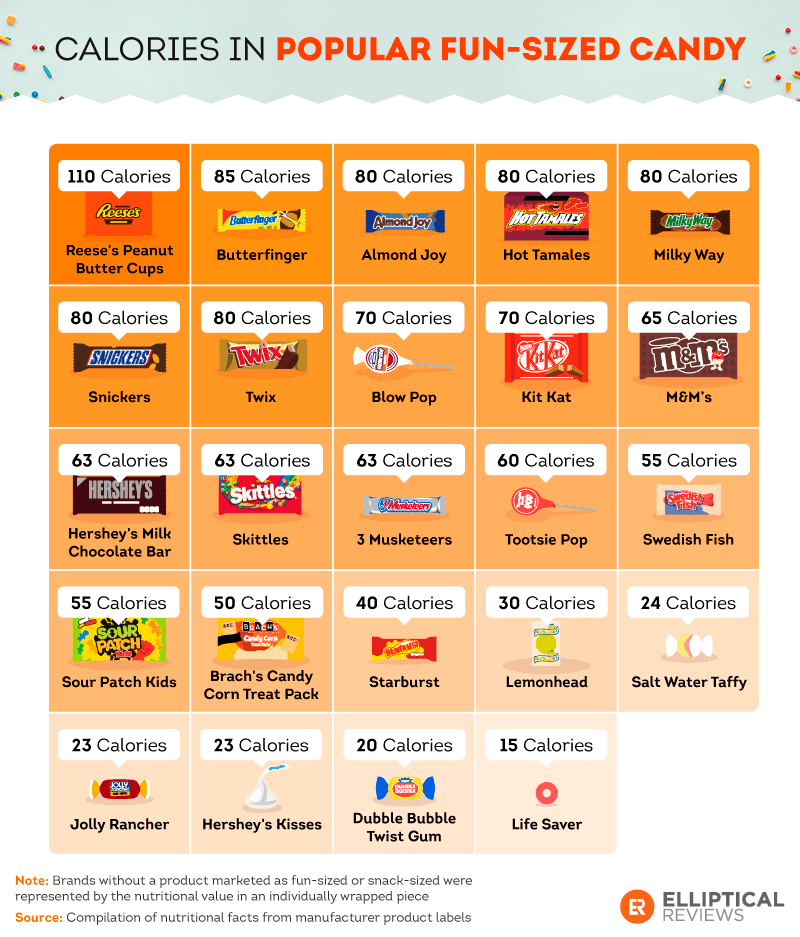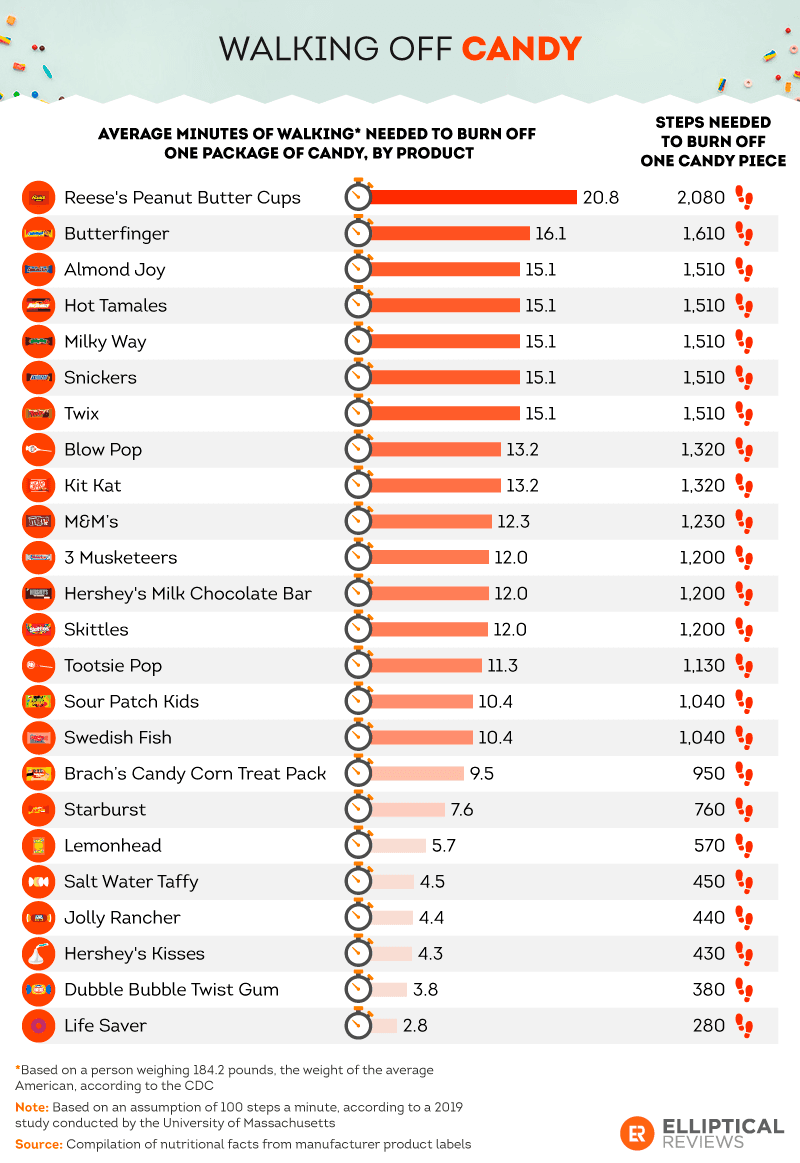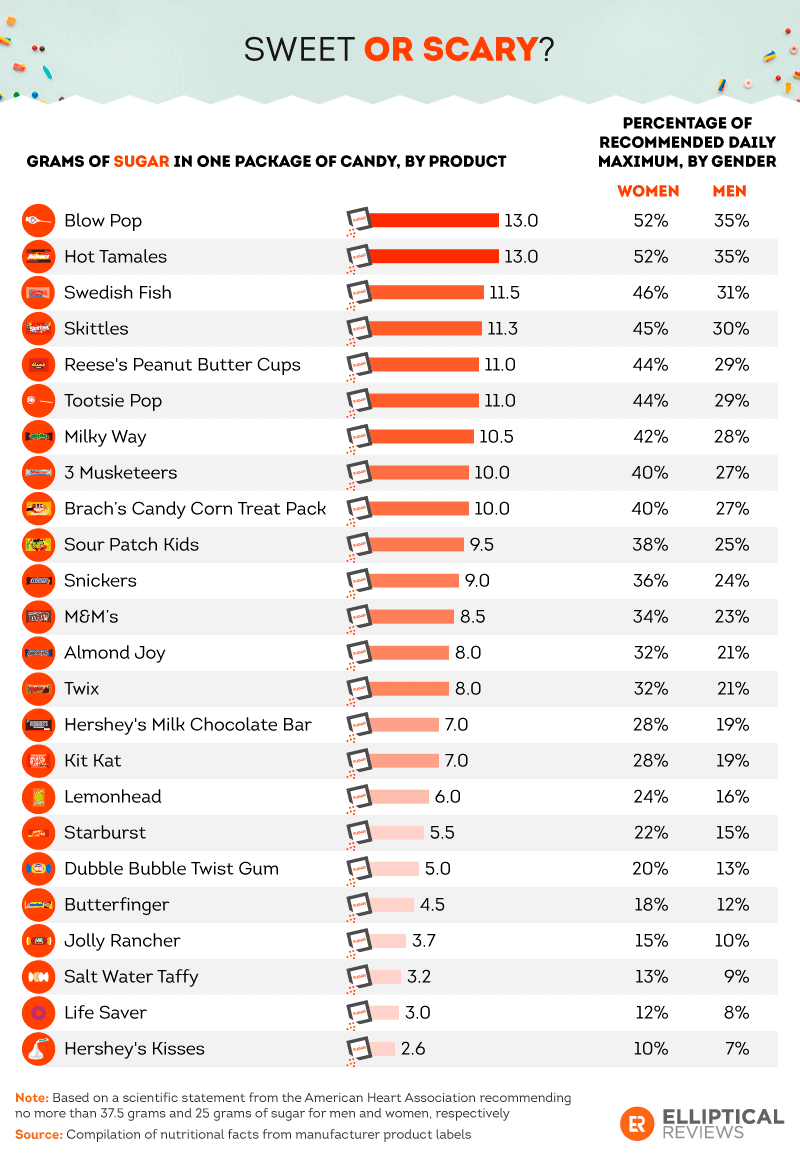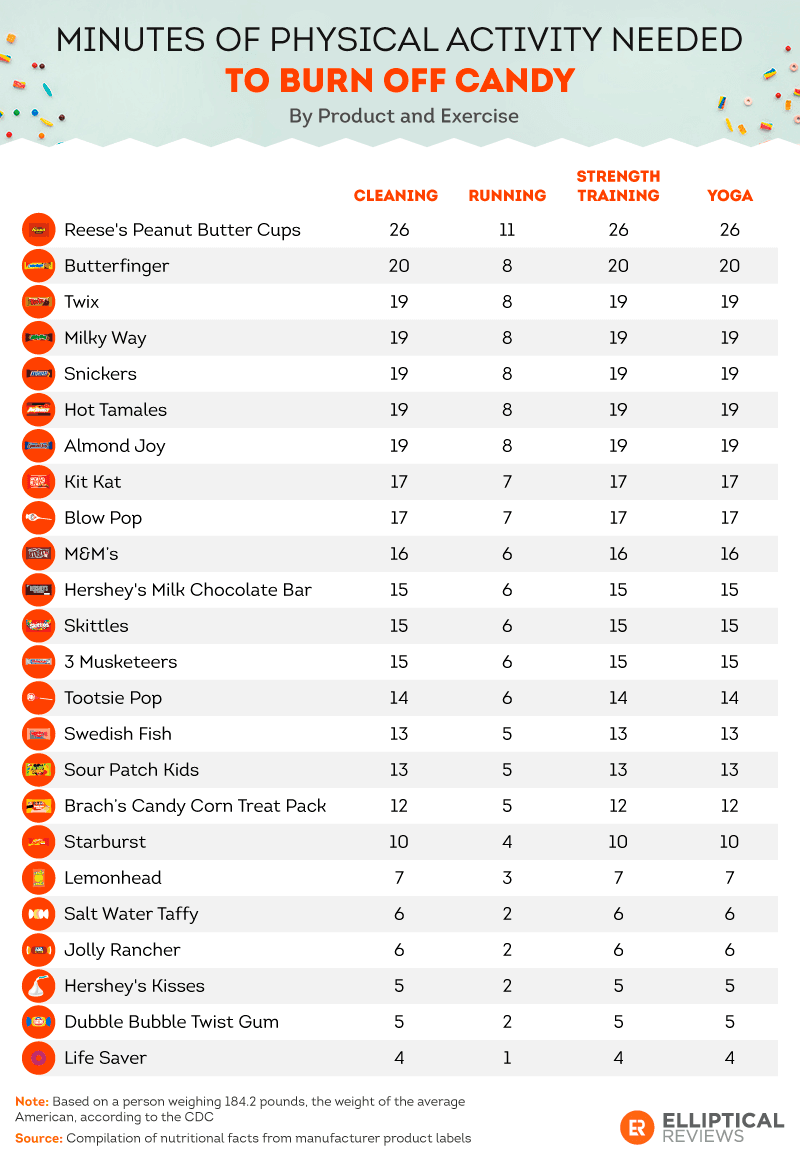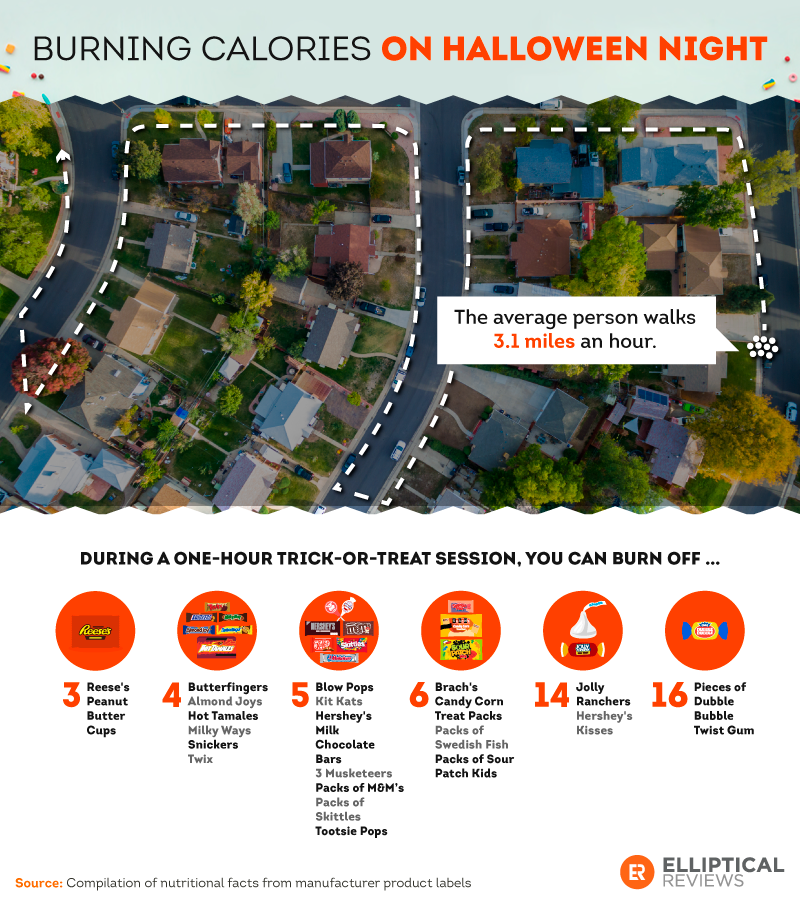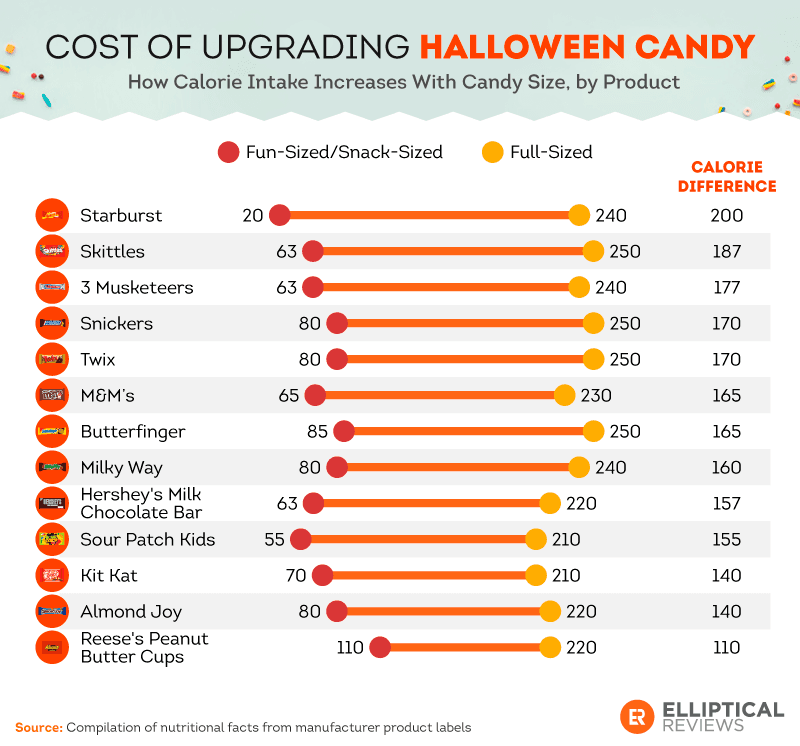From Reese’s Peanut Butter Cups and Snickers to Skittles and Starbursts, the candy we indulge on throughout the year, particularly during the fall season, isn’t completely harmless. And the satisfying flavors of our favorite candy do an excellent job of encouraging us to ignore just how detrimental they can be to our health. Underneath the wrappers, an enormous amount of sugar – an ever-present ingredient contributing to America’s obesity epidemic and numerous diet-related chronic diseases.
But consider your daily routines, purposeful travel between home and the workplace, and evening strolls around the neighborhood – those small ventures counteract at least the majority of the sugar and calories consumed from sneaky dips into the candy jar, right? Maybe not. To learn how much effort it really takes to work off candy, we figured out how many calories and grams of sugar are in the best-selling sweets and compared them to the calories burned by various exercises.
Calorie Count
Between chocolate bars, gummies, and hard candy, no two treats are created equal. But despite the health benefits of dark chocolate, even the “healthiest” chocolate bars can come with a ton of calories. Overall, gummies and hard candy seemed to contain significantly fewer calories than chocolate treats. While Life Savers, Dubble Bubble Twist Gum, and Hershey’s Kisses had the fewest calories – with each piece containing 23 calories or less – Reese’s Peanut Butter Cups, Butterfingers, and Almond Joys had 80 to 110 calories in each individual-sized package.
Steps in the Right Direction
Everyone knows staying stationary for too long is bad for their health, and while the magic number is 10,000 steps per day, how many are actually needed to work off just one piece of fun-sized candy? As expected, the exercise required to burn off candy is heavily tied to the number of calories in each piece, making Life Savers the easiest to work off. With approximately 280 steps, a person of average weight can burn off the calories in a single Life Saver.
On the flip side, chocolate treats take significantly more effort. Burning off one Almond Joy, Milky Way, Snickers, or Twix would take around 15 minutes of walking or roughly 1,510 steps, while 16.1 minutes or 1,610 steps would negate one Butterfinger. Once again, Reese’s Peanut Butter Cups topped the chart, taking 20.8 minutes of walking or 2,080 steps to burn a single cup.
Working off one piece of candy may take a large portion of the daily step count, but it’s important to consider the size and how many pieces of candy people are truly eating. It’s difficult for someone to snack on just one piece of bite-sized candy – you can thank your brain for that – so being mindful of what it takes to work off just one piece may help people modify their consumption habits.
Scary Truths About Sugar
Calories are only one aspect of candy to consider, though. Sugar has infiltrated its way into nearly every product on the shelf, many of which don’t even correctly advertise their sugar content. But it’s this ingredient that is typically held responsible for obesity and a myriad of diet-related chronic diseases.
On Halloween, Americans consume staggering amounts of it. Eating just one Blow Pop or a small box of Hot Tamales comes with 13 grams of sugar – which amounts to 52% of women’s and 35% of men’s recommended daily maximum intake.
Despite having the most calories, Reese’s Peanut Butter Cups tied with Tootsie Pops for sugar with 11 grams per package of candy. Nevertheless, a single peanut butter cup took up 44% of women’s recommended daily intake and nearly 30% of men’s.
On the lighter side, Hershey’s Kisses and Life Savers contained just 2.6 and 3 grams of sugar, respectively, for each piece, taking up a much smaller percentage of both men’s and women’s recommended daily maximums.
Working It Off
Walking isn’t the only way to burn off Halloween treats – but it may be one of the quickest. To work off just one Reese’s Peanut Butter Cup, a person of average weight must clean, practice yoga, or do strength training for approximately 26 minutes. Of the four considered activities, running was the fastest way to burn calories, with just 11 minutes of running negating the calories in a fun-sized Reese’s Peanut Butter Cup. And for Life Savers, the few calories can be quickly burned with just four minutes of cleaning, strength training, or yoga – or only one minute of running.
Laps Around the Neighborhood
Some may view trick-or-treating as an exercise in itself – whether you’re a parent, child, or an adult who likes to dress up and collect candy. But a quick trip around the block won’t do much in terms of burning off candy consumed. In fact, it takes one hour of trick-or-treating to burn off just three Reese’s Peanut Butter Cups.
The slightly lower calorie counts of Butterfingers, Almond Joys, Hot Tamales, Milky Ways, Snickers, and Twix means slightly less effort – in an hour of trick-or-treating, about four fun-size packages of each of these candies can be burned. But even when the candy is somewhat-good-for-you chewing gum, it still requires some physical effort to burn: One hour of trick-or-treating would burn 16 pieces of Dubble Bubble Twist Gum.
Fun to Full
So far, all of our calculations have been based on fun- or snack-sized candy, but even on Halloween, full-sized candy is always preferred – at least by children. But this could cost you. Starburst may be one of the lower-calorie treats, but upgrading to the full-sized candy increases the calorie content by 200 calories. The same goes for Skittles – while the fun-sized pack has just 63 calories per package, the full-sized package of candy costs an extra 187 calories.
On the flip side, upgrading the highest-calorie fun-size candy, Reese’s Peanut Butter Cups, has the smallest difference. While consuming one piece of snack-sized Reese’s costs 110 calories, upgrading to the full-sized candy only doubles the calorie intake, bringing the total to 220 calories. (The fun-sized version contains a single peanut butter cup, while the full-sized counterpart has two.) Almond Joy and Kit Kat also have a relatively low upgrade difference, with full-sized products containing just 140 more calories.
Sour Side to Sweets
Halloween is a time to embrace the make-believe and wear costumes to gain some candy. But there’s a very real side to the fun, and its name is sugar. Sneaking a hand into the candy bag may seem innocent considering the pieces of fun-sized candy are so small, but the size doesn’t accurately reflect how many calories each bite costs or how many grams of sugar are hidden inside.
A single Reese’s Peanut Butter Cup has over 100 calories, and burning it off isn’t all that simple. Trick-or-treating certainly counts as a light workout, but unless you’re doing it for more than an hour, limiting your intake of bite-sized candy is the best way to stay on track with your health goals.
Still, if you’re in need of a Halloween treat, a moderate to vigorous workout can help counteract the cheat – but finding the right workout equipment is key. At Elliptical Reviews, our goal is to do the work for you. Our comprehensive database has hundreds of unbiased reviews, so you can be sure that you’re making an informed purchase. To learn more, visit us online today.
Methodology
Products that fell within any of the 50 states’ top three best-selling candy during 2018 as presented by Patch.com were included in this study, resulting in a total inclusion of 24 best-selling candies. Product sizes used to represent candy in this study and their corresponding nutritional information can be found at the links below:
Brach’s Candy Corn Treat Pack
Hershey’s Milk Chocolate Bar 0.45 oz. (Fun-Sized)
Hershey’s Milk Chocolate Bar 1.55 oz. (Full-Sized)
Milky Way 0.60 oz. (Fun-Sized)
Milky Way 1.84 oz. (Full-Sized)
Snickers 0.60 oz. (Fun-Sized)
Snickers (Full-Sized) – No information on grams or ounces provided
Hot Tamales 0.78 oz. (Fun-Sized)
Hot Tamales 1.80 oz. (Full-Sized)
Jolly Rancher
Butterfinger 0.65 oz. (Fun-Sized)
Butterfinger 1.9 oz. (Full-Sized)1
Skittles 0.54 oz. (Fun-Sized)
Almond Joy 0.60 oz. (Fun-Sized)
Almond Joy 1.61 oz. (Full-Sized)
Life Savers
Reese’s Peanut Butter Cup 0.75 oz. (Fun-Sized)
Reese’s Peanut Butter Cups 1.5 oz. (Full-Sized)
Swedish Fish 0.5 oz. (Fun-Sized)
Starburst 2.07 oz. (Full-Sized)
Kit Kat (Snack-Sized) – No individual ounces information provided
Sour Patch Kids 0.5 oz. (Fun-Sized)
Sour Patch Kids 2.0 oz. (Fun-Sized)
3 Musketeers 0.5 oz. (Fun-Sized)
3 Musketeers 1.92 oz. (Full-Sized)
These values were accurate as of September 5, 2019. Publicly available nutrition values can fluctuate with recipe and portion sizing changes made by the manufacturer.
1Butterfinger listed two sugar values on-site for their 1.9-ounce bar: 21 grams and 24 grams. The value listed on what appeared to be a nutrition label screenshot, 21 grams, was used for this study.
2Patch.com qualified salt water taffy products as best-selling in several states but did not specify which brand of taffy. For the purpose of this study, nutritional values for one piece of Sweets Salt Water Taffy was used to represent this entry.
A media report discussing the University of Massachusetts’ exploratory study on walking cadences can be found here.
The length of time needed to burn off the calories in each candy was based on estimated metabolic equivalent (MET) scores for the listed activities. MET scores vary with a person’s specific weight. The Harvard School of Health defines a single MET as the energy the body uses to sit quietly. MET scores of 3.0, 7.5, 3.8, 3.0, and 3.01 were used to make relevant calculations for yoga, running, walking, strength training, and cleaning, respectively.
Fair Use Statement
Nobody likes hearing about the dark side of their favorite sweets, but being informed of various candy contents is vital to staying on track with health goals. If you’d like to share our findings with a sweet tooth, the graphics and content found here are available for noncommercial reuse. Just make sure to link back to this page to give the authors proper credit.



